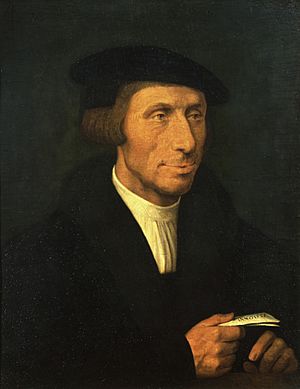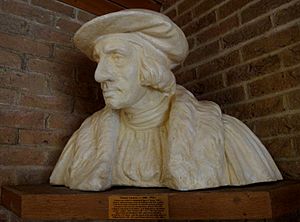Thomas Linacre facts for kids
Quick facts for kids
Thomas Linacre
|
|
|---|---|

A likely portrait of Thomas Linacre
|
|
| Born | c. 1460 Brampton, Chesterfield, in Derbyshire
|
| Died | 20 October 1524 (aged 63–64) |
| Nationality | English |
| Other names | Lynaker |
| Occupation | humanist scholar, physician, clergyman |
Thomas Linacre (born around 1460, died October 20, 1524) was an important English scholar and doctor. He lived during a time called the Renaissance, which was a period of great learning and new ideas. Linacre College at Oxford University and Linacre House at The King's School, Canterbury, are named after him.
Linacre was more focused on studying and learning than on doing scientific experiments. People in his time thought he was a very skilled doctor. He stayed out of politics and religious arguments. His life as a scholar shows how much learning changed during his time.
He was one of the first English people to study Greek in Italy. He brought back new ways of thinking and learning to England and to Oxford University. Some of his teachers were famous scholars. He also taught many important people, including Erasmus, Sir Thomas More, Prince Arthur, and Queen Mary I of England. He was good friends with other well-known scholars like John Colet and William Grocyn. Many people across Europe respected him.
Contents
Thomas Linacre's Life
Linacre was born in Brampton, near Chesterfield, in Derbyshire. His family was very old and even mentioned in the Domesday Book. He went to school at Canterbury Cathedral. His teacher, William Tilly of Selling, encouraged him to study classic languages like Greek and Latin.
Linacre started at Oxford University around 1480. In 1484, he became a fellow at All Souls College. Soon after, he traveled to Italy with William Selling, who was on a trip for King Henry VII. Linacre went with him to Bologna.
Studying in Italy
In Italy, Linacre learned from famous teachers like Angelo Poliziano in Florence. He even studied with the sons of Lorenzo de Medici. One of these sons later became Pope Leo X, who remembered Linacre from their time together.
Other important people Linacre met in Italy included Demetrius Chalcondylas and the printer Aldus Manutius from Venice. Linacre was even part of Aldus's New Academy, a group of scholars. He earned his medical degree with high honors in Padua.
When he returned to Oxford, Linacre was full of the new ideas from the Italian Renaissance. He joined a group of brilliant scholars at Oxford, including John Colet and William Grocyn. These scholars are mentioned in the letters of Erasmus.
Doctor to the King
Linacre did not seem to practice medicine much in Oxford. Around 1501, he was asked to be a tutor for the young Arthur, Prince of Wales. When Henry VIII became king in 1509, Linacre became the king's doctor. This was a very important job at the time.
He practiced medicine in London and treated many powerful people. These included Cardinal Wolsey and Archbishop William Warham.
Later Life and Legacy
After several years as a doctor, Linacre decided to study theology and become a priest. Around 1509, he became a priest and took on several church roles. He became the rector of Wigan in 1520 and held this position until he died in 1524. His church jobs included being the Precentor of York Minster.
Linacre spent his later years on his studies and helping to set up the Royal College of Physicians. This college was his most important contribution to medicine. He helped get a royal charter for it and became its first president. He also left his house and library to the college.
Before he died, Linacre also got permission from the king to create special teaching positions for medicine at Oxford and Cambridge universities. He set aside money to support these positions. Two teaching roles were created at Merton College, Oxford, and one lecture at St John's College, Cambridge. Today, the Linacre professorship of anatomy at Oxford continues his legacy. St John's College still uses the funds for an annual "Linacre Lecture" on medical topics.
Linacre is remembered on a monument in the crypt of St Paul's Cathedral in London. His original burial place was lost in the Great Fire of London in 1666. An old inscription about him said he was a great doctor who helped many people. It also mentioned his translations of Greek works into Latin and his book on Latin grammar. It praised him for being honest and a loyal friend.
Linacre's Works
Linacre wrote scholarly works and translated texts from Greek. He wrote a book on Latin grammar called Progymnasmata Grammatices vulgaria. He also wrote a book about writing correct Latin, De emendata structura Latini sermonis. This book was published in London in 1524 and reprinted many times in Europe.
Linacre's only medical writings were his translations. He wanted to make the works of the ancient Greek doctor Galen available to everyone who read Latin. He translated several of Galen's important medical books. He also translated an astronomy book by Proclus for Prince Arthur in 1499.
His translations were known for being very accurate and well-written. They became the standard versions of those parts of Galen's writings. They were often reprinted.
Linacre was very careful and precise in his work. This is why he did not leave behind more written works. However, scholars like Erasmus greatly admired his Latin writing style and his sharp judgment. People said he was a master of Greek and very knowledgeable about ancient philosophers and naturalists. Everyone agreed that Linacre was a person of high moral character.
See also
- List of Erasmus's correspondents
- Linacre Quarterly
- List of Roman Catholic scientist-clerics


